Tomatoes are a popular and diverse vegetable, and they can be cultivated year-round in greenhouses in regions with temperate climates. The average height of a tomato plant is 3-10 feet. These crawling plants have a weak, sprawling stem and usually require some support to grow. Tomato plants that remain indeterminate throughout their growth are perennial in their natural environment but are grown as annuals in the garden. The tomato’s breadth can vary from 1 centimeter (4 inches) to 10 centimeters (4 inches), depending on the variety.
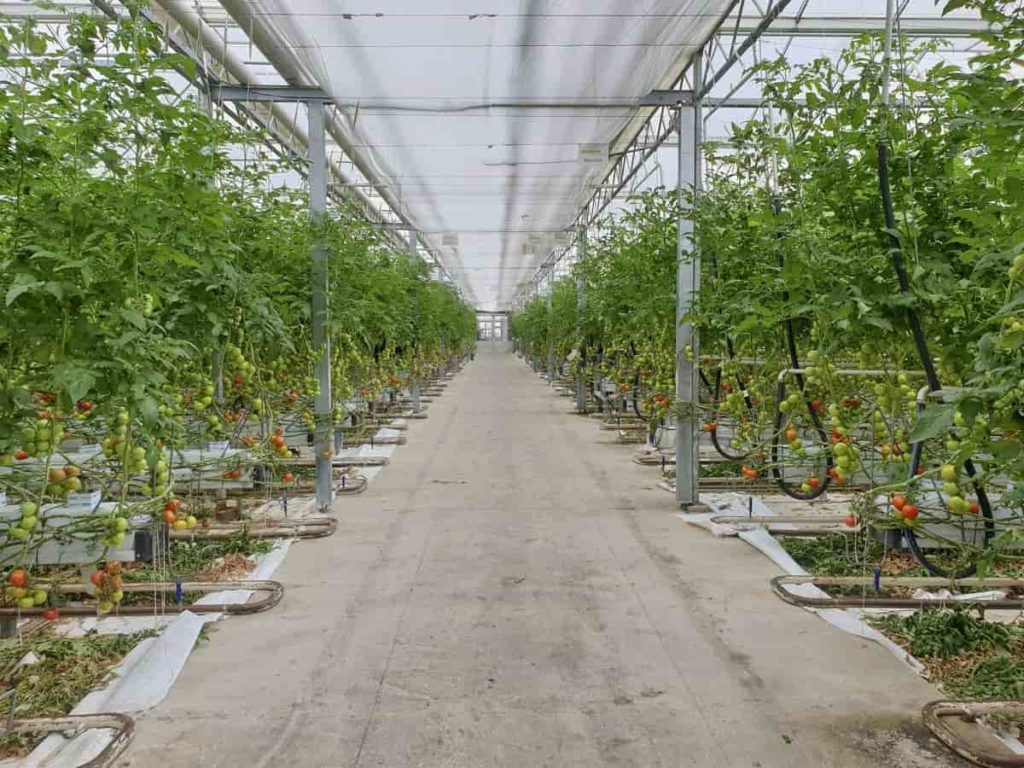
The Philippines cultivates tomatoes extensively as a secondary crop because of the popularity of this fruit vegetable. It has a broad temperature range of roughly 18 to 30 degrees Celsius in which it thrives. Tomatoes do best in acidic soil (pH 5.8-6.5), like deep sandy loam. The tomato is a member of the Solanaceae family of plants. The first harvest occurs three to four months after planting, and the crop can be harvested anywhere from five to fifteen times in a season.
Fresh tomatoes typically last seven days when stored at room temperature and humidity. Tomatoes have exceptionally high levels of vitamins A and C. Fiber, beta carotene, iron, magnesium, niacin, potassium, phosphorus, riboflavin, and thiamine are also in high concentrations. In addition, it has a lot of lycopene and antioxidants, which eliminate free radicals in the body that can cause cancer.
How to start tomato farming in Philippines
The top tomato-producing region in the Philippines
There are several major tomato-growing areas in the Philippines. Region I (Ilocos Region) produces 73,324.87 MT, Region X (Northern Mindanao) produces 48,528.56 MT, Region III (Central Luzon) produces 31,452.8 MT, Region IV-A (CALABARZON) produces 16,016.93 MT, and Region VI (Western Visayas) produces 11,484.12 MT.
In case you missed it: Ohio Vegetable Planting Calendar: Month-by-Month Chart, Season, and Easiest Vegetables to Grow
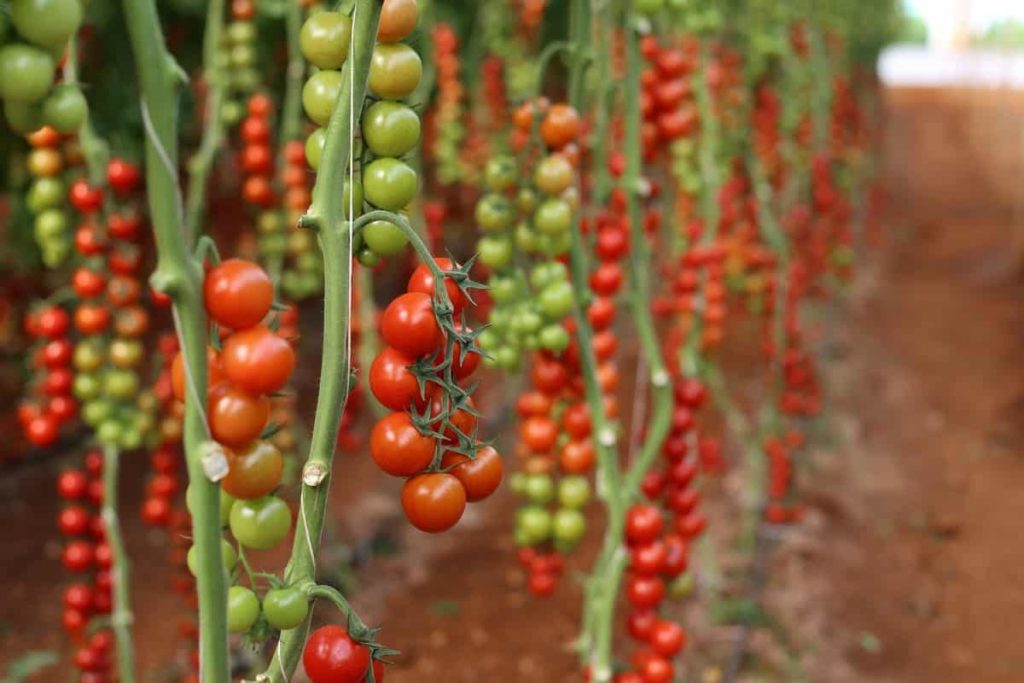
Ilocos Region
With a total production area of 800 hectares, tomato is one of the high-value cash crops grown in the Ilocos Region of the Philippines. Following the harvest of the primary rice crop, it is planted between October and December. As a result, tomatoes grown by NFC farmers and producers often harvest in January. Fresh ripe tomatoes, especially the “Ilocos Red” kind, are purchased from 3,000 farmers in Ilocos Norte and Ilocos Sur and processed by NFC into tomato paste.
The farmers sign into a contract is growing arrangement with the NFC at the beginning of each season. This agreement allows the NFC to give farmers technical assistance and to arrange financing with lending institutions for inputs such as fertilizers, pesticides, harvest containers, and other inputs.
The processing capacity of the NFC is 500 metric tons (MT) of tomatoes per day, and during the processing season, which runs from January to April each year, the company produces approximately 4,000 MT of tomato paste. As a result, NFC provides 13% of the yearly 30,000 metric ton consumption of tomato paste by supplying it to the country’s biggest restaurant chains, fish canners, and manufacturers of tomato sauce and ketchup.
Northern Mindanao
The production of some vegetables and root crops in Northern Mindanao accounted for 15.2 percent of the total production of those items across the entire country. In 2020, Northern Mindanao supplied the vast majority of the country’s tomato harvest. This region produced 34,861 MT of tomatoes, equivalent to 65.1 percent of the country’s total tomato output.
Central Luzon
Because of the significant danger of crop failure, tomato production is typically avoided during the hot and wet season (June to November) in lowland areas of Central Luzon, Philippines. Crop productivity is affected by factors such as heat, root infections, and flooding caused by monsoon rains.
During this period, commercializing tomato production may be accomplished by using techniques such as grafting, bedding, and shelters. The production of tomatoes on Central Luzon’s island accounts for approximately 12.6% of the country’s overall production.
Varieties of tomatoes in the Philippines
Determinate tomatoes
Tomatoes that are determinate blossom and set fruit simultaneously, and then they die off. The flowers they produce at the tips of their stems ultimately limit their height. These kinds tend to be small, bushy plants that need neither pruning nor staking unless they are “vigorous” variants, which bear fruit so heavy they must be maintained.
In case you missed it: Top 43 Kitchen Garden Ideas for Beginners: That Every Gardener Should Know
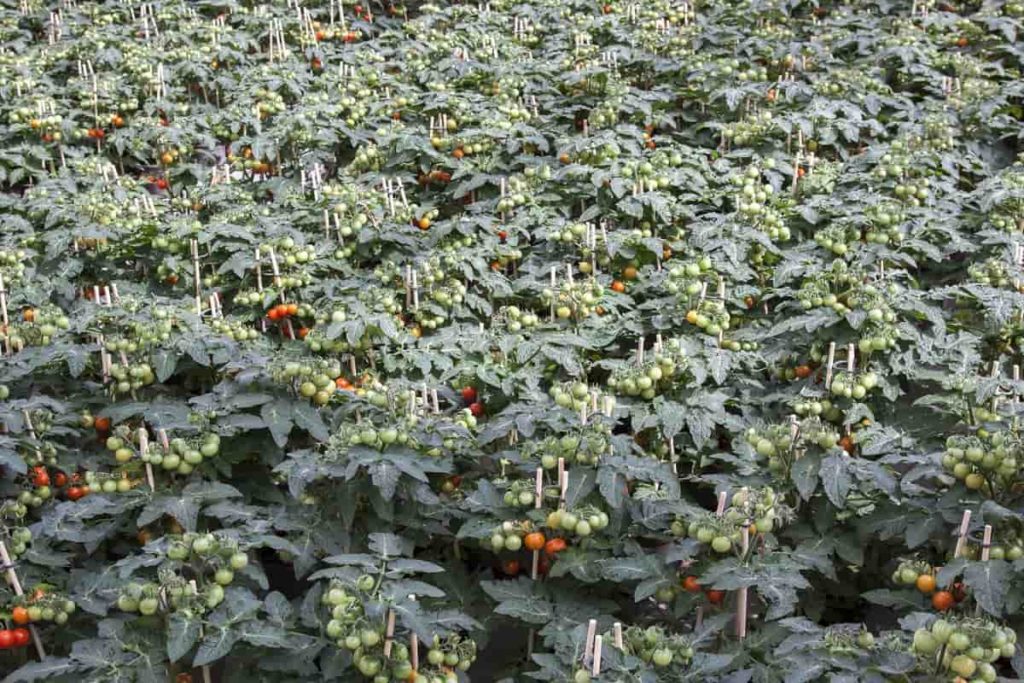
Indeterminate tomatoes
Tomatoes with an indeterminate growth pattern are in it for the long haul. Because the flowers bloom all along the stems rather than at the tips, they keep growing and producing tomatoes all summer long. However, they need support or pruning because they don’t reach a specific height but continue to expand until halted by weather or clippers.
Heirloom tomatoes
Growing tomatoes from seeds with desirable features, retaining the seedlings that preserve those qualities, and discarding the ones that don’t is how heirloom tomatoes were produced through many years and generations. Over time, the line was improved by breeding fewer and fewer seeds that failed to yield plants with the necessary features.
Key to the success of heirlooms is the fact that they have been open-pollinated for generations. Their essential characteristics are consequently encoded in dominant genes, giving them an advantage over rivals and cross-pollinated varieties, at least for the time being. Seeds from heirloom plants will breed true if they are grown in relative isolation from other kinds. Still, cross-pollination will inevitably lead to changes if they are planted near other tomato varieties.
Hybrid tomatoes
Hybrids are the product of artificially combining genes from two separate species. Since no effort is made to create a “seed line” for hybrids, they are created from scratch yearly by repeatedly crossing the same parent strains. When creating hybrids, pollen from one species is utilized to fertilize blooms of another species, bypassing the need for the natural process of open pollination. If you look at the generation before the one that you’re buying, you can see the effects of cross-pollination.
In other words, the “parents” of the hybrid tomato plant are two completely distinct sorts, and the seeds produced by the hybrid include DNA from each of these types in various permutations. Because of this, you can’t assume that the seed will grow into a plant with the same genetic structure as its mother. You have no idea which of the two “parents” provided the gene for, say, size, firmness, or skin toughness in any given seed.
Best season for tomato farming in the Philippines
Tomatoes can be grown in the Philippines at any time of the year. However, the intense summer heat causes these plants to perish and lose their blossoms. Therefore, the optimum time to plant seeds in the Philippines is from September to the completion of the rainy season in late October or early November. After a rest period, mature tomato plants should begin yielding fruit again in late winter or early spring, when temperatures and daylight hours are optimal for plant growth and fruit development.
Tomato cultivation is often avoided during the hot and wet seasons (June to November) in lowland areas of Central Luzon in the Philippines. This is due to the considerable risk of crop failure associated with producing tomatoes during this time. The level of crop production can be influenced by a variety of environmental conditions, including temperature, the presence of root diseases, and flooding brought on by monsoon rains. Techniques such as grafting, bedding, and shelter can be utilized during this period to facilitate the commercialization of the tomato production process.
Soil preparation for tomato farming in the Philippines
Tomatoes can thrive in a wide variety of soils, but they do particularly well in rich, loamy soils that are well-drained and have strong drainage ability. It is generally agreed that sandy loam to medium black soils is the ideal conditions for tomato growth. The PH of the soil must be between 6-7 for tomato production, and it must also have excellent drainage properties. To ensure your tomato plants grow and provide fruit, choose a spot with at least six hours of sunlight per day.
In case you missed it: How to Start Home Gardening in Asia: For Indoors, Outdoors, Raised Beds, Backyards, Terrace, Pots, and In Containers for Beginners
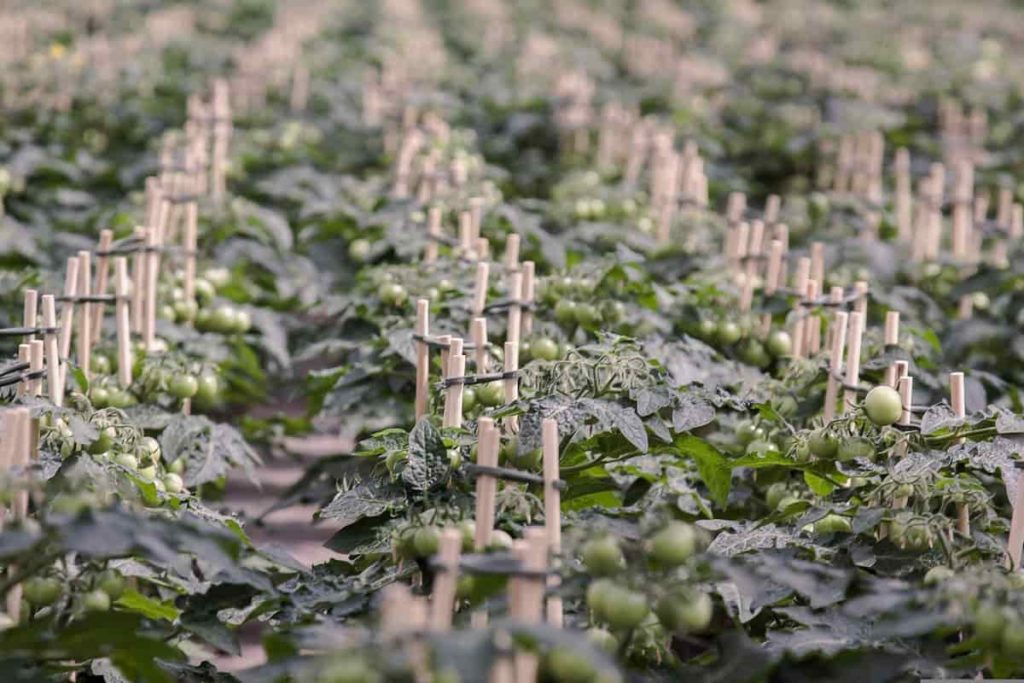
It is important to keep your tomato farm away from any trees that can cast a shadow on it for part of the day. You may either use a shovel or a tiller to break up the soil in the area where you intend to put your farm so that it will be more suitable for the tomato plants you intend to grow. Dig down sufficiently enough to get rid of any plants or grasses, along with their root systems, that are growing on the soil’s surface. You can use your hands or a garden hoe to break up clumps of soil and make the soil easier to work.
The roots of your tomato plants may have trouble breaking through large clods of difficult soil. Because different plants do well in soils with varying pH levels, knowing your soil’s pH level is essential. In addition, knowing the nutrient levels in the soil will help you decide how much fertilizer to give your tomato plants. Collect soil samples from the area you intend to plant tomatoes and have them tested with a commercial kit. The soil should contain a balanced amount of nitrogen, potassium, and phosphorus for your tomato plants to thrive.
The soil should be retested after adding a natural nitrogen source to ensure that the new amount has no adverse effects. Use a shovel to combine the nitrogen source with the topsoil and compost. Use a slow-release fertilizer to supply your tomato plants with the nutrients they need if your soil is deficient. Although artificial fertilizers aren’t as eco-friendly as their natural counterparts, they can swiftly boost your soil’s nutrition levels. Incorporate the fertilizer into the soil and compost at the surface.
Spacing of the tomato plants for productivity
If you aren’t ready to plant yet, keeping the soil covered with black plastic is best. The sudden change in temperature can less stress tomato plants by planting them in warm soil two weeks before the actual planting date. Covering the tilled soil with a layer of black plastic is recommended to allow the soil to warm up more quickly in the sun. Then, when you’re ready to plant your tomatoes, take off the plastic.
A minimum of 130 centimeters (50 inches) should separate rows, and 61 centimeters (2 feet) should separate plants within a row. For ease of watering and weeding, leave a few inches of space around each plant. To facilitate harvesting, watering, and weeding, space your plants in rows no closer than 50 inches (130 cm) apart. Try to bury the plant up to two-thirds of its stem.
Tomato plants can adjust more quickly to new soil conditions if the stems are buried to a considerable depth. To plant tomatoes, make a shallow hole in the ground, insert the stem, and fill in around it so that just a third of the plant is visible above the ground. Put a stake next to each plant, spacing them out by about 2 inches (5.1 cm). A tomato plant without some support will eventually topple over or droop to the ground. Therefore, stakes should be inserted into the ground to prevent subsequent root damage.
Irrigation or Water management
From the time of transplantation until the final harvest, which occurs 14 days later, four to five irrigations may be required, depending on the soil type. Tomatoes are highly susceptible to floods. Thus, great care must be taken during flowering and harvesting to irrigate only the root zone. Furrow irrigation (rapid passage) helps prevent soil erosion and promotes fruit establishment.
A period of 24 hours of waterlogging will promote the spread of wilt diseases and inhibit fruit set. Water the plants once each week, at a rate of 1 liter per hill, starting two weeks before the final harvest if you can’t rely on surface watering. It is recommended to water tomatoes growing in plastic mulch twice each week for the duration of the crop.
Fertilizer management
Commercial tomato farms either utilize synthetic fertilizers or composted organic matter. Pre-transplant fertilization, side-dressing in a furrow irrigation system, and drip irrigation are the most common fertilizer application methods. The process of injecting a chemical such as nitrogen, phosphorus, or insecticide into irrigation water and then applying that water to land through an irrigation system is called “chemigation.”
Outside of the broken section of the bed, side dressing is required using a liquid injection wheel, drip irrigation, or bandaging. Drip irrigation and fertigation are the most common methods of growing tomatoes.
In case you missed it: Tips to Start a Goat Farming Business: Check How this Guide Helps Beginners
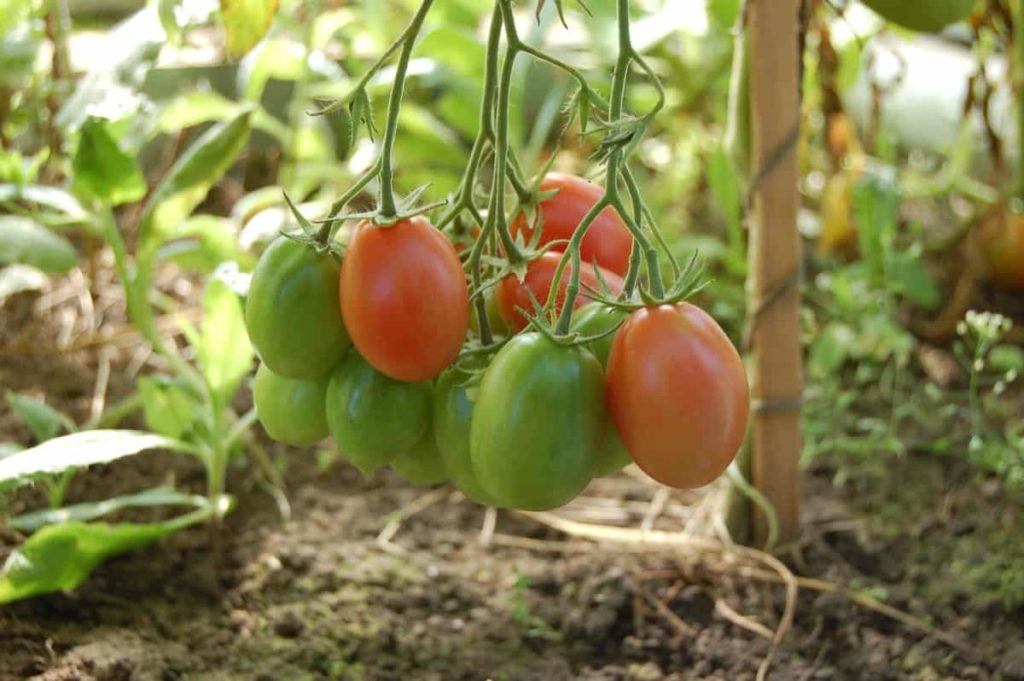
Before laying down plastic, make sure the bed has been amended with all of the necessary nutrients, including phosphorus (P) and micronutrients, and between a third and a half of the recommended nitrogen (N) and potassium (K). Starting one week following transplant establishment, apply the remaining N and K through fertigation. These fertilizers are applied at varying rates depending on the crop’s growth stage.
Pest and disease management
Chemical, biological, and remedial techniques are used to control tomato pests and diseases. There is a vast range of pests and diseases that can affect tomatoes at any time of the year, with the exception of thrips and whiteflies, both of which are only a problem during the dry season (January–May) and disappear as rain begins. Therefore, the farmer or backyard gardener might use biological and remedial methods to combat insect pests and diseases.
Common pests that prey on tomatoes include: tomato bugs, stink bugs, cutworms, tomato hornworms, tobacco hornworms, aphids, cabbage loopers, whiteflies, tomato fruit worms, flea beetles, red spider mites, slugs, Colorado potato beetles, and Colorado potato worms. The tomato russet mite, Aculops Lycopersicon, feeds on the plant’s foliage and young fruit, which can lead to the premature death of the plant due to the necrosis and shrinking of its leaves, blossoms, and fruit.
Systemin is a plant peptide hormone produced in response to insect damage in tomato plants. Systemin stimulates anti-growth mechanisms by inducing protease inhibitor synthesis. Tomatoes were the first to have their hormone discovered, but identical proteins have since been found in other organisms. As a result, the disease resistance of different tomato varieties varies greatly. These disease-resistant traits are a primary area of research for modern hybrids, which have mostly replaced traditional varieties.
The tobacco mosaic virus is a frequent disease of tomatoes. Tomato plants are susceptible to catching the virus via handling contaminated tobacco items, including cigarettes and other tobacco products. Curly top, transmitted by the beet leafhopper, is another devastating disease that causes a breakdown in the life cycle. The disease’s symptoms include, as the name suggests, abnormal growth and wrinkling of the plant’s upper leaves.
Pruning method
Indeterminate tomato varieties are the only ones that need pruning. Reduce the number of branches on the main stem to 4 or 5 to encourage the plant to put its energy into tomato production. If new shoots appear at the leaf nodes or suckers, pinch them off. Tomatoes can be stunted in their growth by suckers, which are harmful to plants.
Harvesting
When the fruits have reached the mature green stage in the rainy season after 1-2 months, harvest them for future use. When stored at room temperature, mature green fruits will ripen in a month. Consistent picking encourages continued fruit growth. Fruits should be picked at the pink breaker stage if used quickly. When left out at room temperature, these will mature to perfection in about three days, although refrigeration will slow the process.
Tomatoes for commercial use are cultivated close to processing facilities that pack and can tomato products like sauce and paste. When selected at the peak of ripeness, their flavor is at its peak. They are picked around the clock for about a month and a half, then delivered to processing companies that run on the same schedule.
Yield
The volume of tomatoes produced in the Philippines in 2021 reached roughly 225.5 thousand metric tons, an increase from the volume of tomatoes produced in the Philippines in the previous year. As a result, the Philippines is expected to be one of the countries in the Asia-Pacific region with the highest production of tomatoes in the year 2020. In the Philippines, tomato production may be found in several important regions.
In case you missed it: Top 50 Basic Gardening Tips for Beginners: That Every Gardener Should Know
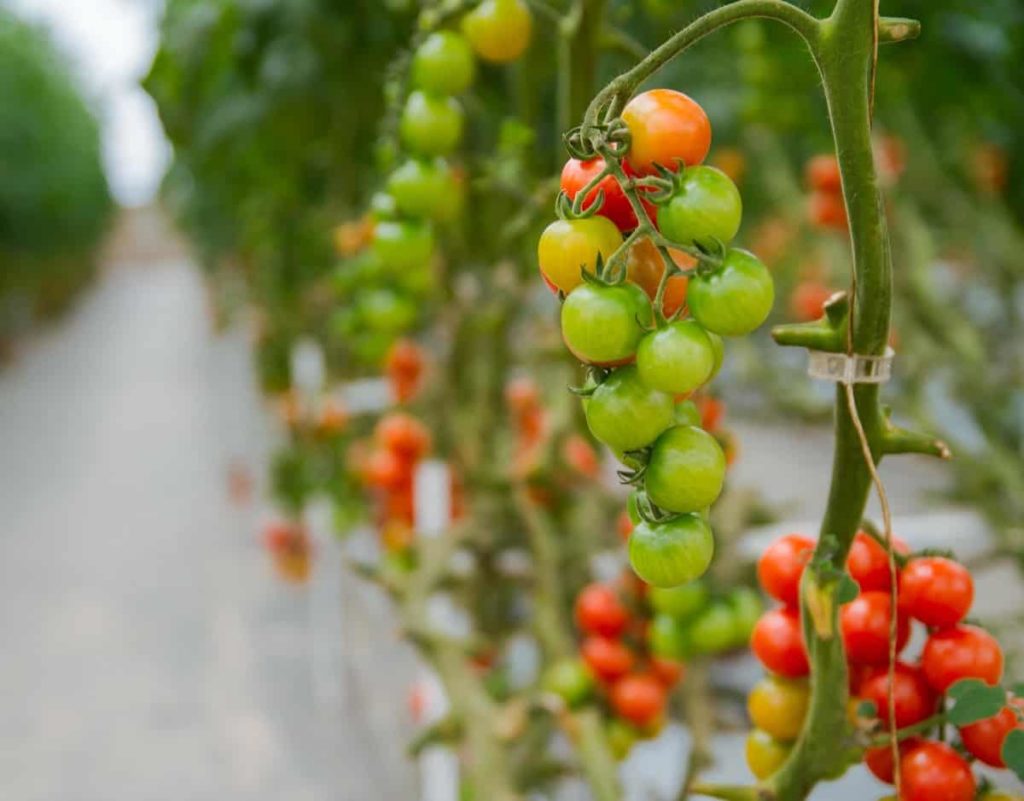
Region I (Ilocos Region) is responsible for the production of 73,324.87 MT, Region X (Northern Mindanao) is responsible for the production of 48,528.56 MT, Region III (Central Luzon) is responsible for the production of 31,452.8 MT, Region IV-A (CALABARZON) is responsible for the production of 16,016.93 MT, and Region VI (Western Visayas) is responsible for the production of 11,484.12 MT.
Tomato yield per hectare in the Philippines
The overall yield experienced an increase of 3.08 percent on an annual basis. In 2012, it was just 10.26 MT per hectare, but by 2020, it had increased to 11.57 MT per hectare. Producing 69.62 thousand metric tons (MT) of tomatoes in 2020, the Ilocos Region was the leading producer, accounting for 34 percent of the country’s total tomato production.
Off-season tomato production in the Philippines
The province of Tarlac is home to highly seasonal tomato production. During the dry season, tomatoes are abundant. Still, during the rainy season, the output is low, resulting in a limited supply in the market with poor quality food that adds to dramatic price volatility. Most of the harvest happens between October and February, leading to a glut on the market in the winter months and a shortage in the wet months of June through November.
Some farmers in the province of Tarlac are expanding their harvests by a few months by growing tomatoes using plantlets grafted onto rootstock. An eggplant variety that does well in the Philippines is resistant to soil-borne pathogens like bacterial wilt and flooding. The Asian Vegetable Research and Development Center has created this tomato grafting process involving protective structures.
This technology facilitates commercial off-season tomato cultivation. The method also extended the harvesting period compared to non-grafted tomatoes, which was an actual result. In addition, the productivity of the grafted seedlings was boosted by using bamboo sticks as plant supports. Therefore, planting tomatoes outside of their traditional growing season and marketing them during that time can lead to profitable tomato production in the Philippines, even during the hottest and rainy times of the year.
Amount of tomato seeds for one hectare of land
Plant 80–100 seeds in each of the 50-centimeter rows. It takes between 150 and 200 grams of seeds to plant in one hectare. The seeds should be covered with a thin layer of soil, and rice straw should be used as mulch.
Conclusion
Tomatoes are a significant cash crop in the Philippines, providing farmers with a reliable source of revenue. The crop’s many potential applications—in food, cosmetics, and other areas—make it an attractive investment domestically and abroad. Demand for tomatoes is consistently high all through the seasons. However, supply is restricted in the off-season, whether it be the extremely dry (planting in February and March) or wet months (June-July planting). Tomatoes are more expensive since supply is limited during the off-season.
High temperatures, relative humidity, and precipitation are typical of the environment in which tomatoes are grown during the off-season months. However, the output of tomatoes is constrained by low fruit sets and the presence of severe insect pests and illnesses. Filipino farmers can increase their income by taking advantage of a potential opportunity to grow tomatoes. However, the most significant risk or difficulty is meeting the daily demands of the market for high-quality tomatoes throughout the year.
- Sheep Farming Business Plan for Beginners
- Aquaponic Farming at Home: A Step-By-Step Guide
- Profitable Village Farming Business Ideas in 2024
- High-Yield Aquaculture: Fast-Growing Fish for Farming
- Effective Fish Pond Construction Techniques for Beginners
- Irrigation and Water Management in Pineapple Farming
- Blossom to Harvest: Mastering Flowering and Pollination in Papaya Farming
- Pig Fattening Essentials: From Selection to Sale for Beginners
- Raising Wagyu Cattle: A Complete Guide for Premium Beef Production
- Soil Types and Their Water Holding Capacity
- Optimizing Irrigation Schedules for Coconut Groves for Enhanced Yield
- Espresso Your Garden: Coffee Grounds for Healthier Acid-Loving Plants
- The Best Soil Mix for Snake Plants: How to Mix Your Own Snake Plant Soil
- Green Thumb Success: Expert Tips for Cultivating Greenhouse Beans All Year Round
- Bloom All Year Round: The Ultimate Guide to Indoor Hyacinth Care
- Eco-Friendly Gardening: How to Make Liquid Fertilizer from Kitchen Waste
- Ultimate Guide to Grow Anise in Pots: Explore Seed Propagation to Harvesting
- Guide to Raising Chester White Pigs: Discover Breed Facts to Growth Management
- Mastering the Elegance: The Ultimate Guide to Weeping Cherry Tree Care, Planting, and Maintenance
- Ultimate Guide to Planting Garlic in Grow Bags: Growing Strategies for Beginners
- How to Fix Spider Plant Leaf-Related Problems: Natural and Organic Remedies
- 10 Reasons Why Your Tulsi Plant is Shedding Leaves: Home Remedies and Solutions
- Optimizing Growth and Yield: The Advantages of Palm Bunch Ash Fertilizer
- Utilizing Neem Oil Extract as a Natural Pesticide for Hydrangea
- From Soil to Harvest: Various Ways in Which Farmers Can Use AI Tools
- Steps to Encourage and Induce Citrus Flowers: A Comprehensive Guide
- How to Fix Snake Plant Leaf-Related Issues: Natural and Organic Remedies
- Transform Your Garden into a Fragrant Oasis with Raat Ki Rani (Night Blooming Jasmine)
- Discover the Ideal Chicken Breeds for Philippine Farms
- How to Create a Poultry Egg Farm Business Plan for Profits
- Grow Lemon Cucumbers Like a Pro: Insider Techniques for Bountiful Yields
- Ultimate Guide to Caring for Your Pink Princess Philodendron: Tips for Thriving Variegation
- Areca Nut Profit Per Acre: Calculating Yield and Cost of Cultivation
- How Kaveri Chicken is Becoming a More Profitable Breed in Indian Backyards
- Transform Your Barn: 9 Steps to Convert a Horse Stall into a Chicken Coop
- Exploring Suffolk Sheep Disadvantages with Limitations and Challenges
